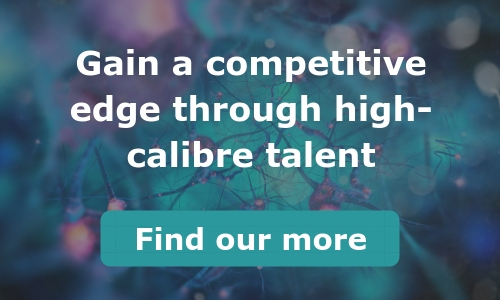Josh Bersin, world-known HR analyst proclaimed, “Diversity and inclusion is a top-to-bottom business strategy – not just an HR program“.
Incorporating diversity in the workplace is a fad. Life science organisations that recognise the benefits of workplace diversity have a significant competitive advantage over those that don’t. The crux, however, is that organisations are uncertain about how to hire for diversity. While many focus on adapting performance job descriptions, posting applications in more diverse domains and diversifying their employer brand to attract diverse candidates, they often forget to train and engage their hiring managers.
While HR is responsible for diversity hiring initiatives, hiring managers are responsible for their team headcount. In many organisations, they get the final decision on a new hire; after all, the successful candidate will be a member of their department and report directly to them. This is supported by 45% of employees believing that hiring managers are ultimately responsible for increasing workplace diversity. This demonstrates the importance of engaging the hiring manager in diversity planning.
Why is diversity important in the hiring process?
Everyone is entitled to fair treatment, especially during the hiring process. If a candidate is qualified for the role, they should have an equal chance of success, no matter their gender, race, age or other demographic differences. During the screening process and interview, if a candidate receives biased or discriminatory treatment, this reflects poorly on your organisation and is unethical. Organisations should always position themselves as equal opportunity employers. Failure to effectively hire for diversity could result in your organisation missing out on the plethora of benefits including:
- Organisations with diverse teams have 19% higher revenue.
- Diverse teams make better business decisions 87% of the time.
- Diverse teams make decision 2x faster and in half the amount of time.
For more information on the benefits of workplace diversity, read our blog: The Ultimate Business Case For Diversity In The Workplace.
RELATED: Increase quality-of-hire by partnering with a reputable boutique talent consultancy
Hiring for diversity has its challenges, but there are actions that you can take to counteract this:
Set diversity hiring goals
Setting attainable diversity hiring goals should be the first step on your agenda. Be realistic about how many diverse candidates you want to apply, interview and hire. You should ensure that all hiring stakeholders are on the same page. If you are working with an external executive search firm or recruiter, ensure they are brought in. Miscommunication or a lack of understanding could scupper your diversity hiring initiative. Establishing a consensus on your remit and targets means that each hiring stakeholder is held accountable for their part in the hiring process.
As the hiring manager, you have a responsibility for building and developing your team. It is paramount that you ensure that diversity is embraced within your team. If your direct reports aren’t on board with workplace diversity, then this could create a hostile work environment, with negative consequences on productivity and wellbeing.
Put time aside
Hiring for diversity inevitably takes longer. Diverse candidates may be harder to find and engage. Chances are, if you’re not already attracting diverse candidates, you’re looking in the wrong place. Consider switching up the channels you recruit through and targeting passive candidates. The longer you sift through applications and candidates, the more it will start to feel like you’re trying to find a needle in a haystack. This can be incredibly frustrating, but it’s important to focus on the benefits of a diverse workforce rather than mulling on the lengthy process.
A longer hiring process can actually be an asset as it allows you to meet more diverse candidates. There’s nothing worse than tight hiring deadlines forcing your decision. If you’re rushed to fill a position, you risk hiring the first decent candidate you interview and omitting brilliant, diverse talent that you haven’t had the time to meet. The lengthy hiring process allows you to optimise your hiring process to find the ideal, diverse candidate.
Acknowledge unconscious biases
The way humans are wired means that they often make decisions based on unconscious biases. Although they might be completely unaware of doing so, this can create all kinds of implications later on.
Before candidates even reach the interview stage, they may be subjected to bias in your job adverts or performance job description. For example, ensure you are not using aggressive language which puts off female applicants.
Hiring managers will be responsible for looking through applications, which is when bias can arise; the hiring manager may unconsciously focus on the name or gender of the candidate, rather than looking at her accomplishments and expertise. To eliminate this bias, Artificial Intelligence (AI) and Machine Learning can be employed in the screening process. This impressive technology can determine a candidate’s performance and ability to do their job, without considering factors like race, gender or nationality. However, a less high-tech approach would be to have someone impartial to look over the applications and remove all personal identifiers (name, age, location) from CVs and pain letters. That way, you can be sure you are qualifying and shortlisting candidates based on the quality of their profile alone.
Another less obvious scenario in which unconscious biases may occur is during interviews. When you interview the candidate, you have a responsibility to ensure that it’s unbiased. An interview encompasses small talk, meaning that if the hiring manager doesn’t immediately click with the interviewee, this might be enough to eliminate them from consideration. These unconscious biases could mean that hiring managers are unlikely to hire a candidate that doesn’t look like them or share the same interests. While rapport is important, it’s not the be-all and end-all. As the hiring manager will be assessed on your team’s ability to deliver results. If your new candidate is ineffective in their role and this impacts team performance, this will reflect badly on the hiring manager.
You should create an interview guideline to follow that includes a list of standardised questions. You will then be able to assess candidates fairly based on the answers they give to these questions. By carrying out interviews this way, you’ll be able to avoid giving one candidate an unfair advantage over another.
Onboarding
While you effectively relinquish your Hiring Manager duties when the candidate accepts a job offer, your responsibility as their manager is only just beginning. Once you’ve successfully hired your new candidate, you need to onboard them effectively while ensuring that team morale is high and that everyone feels valued. While there might be some initial hostility and distrust amongst employees, it’s essential to harmonise the workplace with diversity training. Teams are far more likely to excel if they feel supported and accepted. Once your team are on board and understand the value of diversity, this is when you’ll start to achieve big things.
Conclusion
If you want to give your organisation a real competitive edge, then diversity is the way to go about it. To reap the benefits of diversity, engaging hiring managers is key. Equally, your entire team will have a part to play in hiring a more diverse workforce. Make sure you keep in mind that diversity ranges from organisation to organisation; what might work for your competitors, might not work for you.
For more hiring advice tailored to hiring managers in the life science industry…
- Read The Importance of Workplace Diversity in the Life Sciences.
- View our talent solutions to see how we can help you gain a competitive edge through talent.
* Fraser Dove International is a talent consultancy operating exclusively across the life sciences industry. While our roots lie in executive search, we provide more than the traditional recruitment services. Uniquely placed within the market, we have been providing cutting-edge talent solutions and insight to organisations at all stages of their journey – from start-up to established leaders – since 2013.

 Estimated read time: 5 mins
Estimated read time: 5 mins  Date posted:20/01/2020
Date posted:20/01/2020





